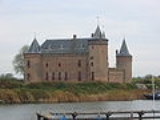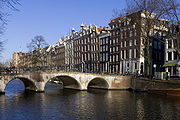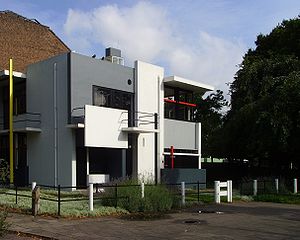
Architecture of the Netherlands
Encyclopedia
Dutch architecture has played an important role in the international discourse on architecture in three eras. The first of these was during the 17th century, when the Dutch empire was at the height of its power. The second was in the first half of the 20th century, during development of modernism. The third is not concluded and involves many contemporary Dutch architects who are achieving global prestige.


roughly beginning at the start of the 17th century. Due to the thriving economy, cities expanded greatly. New town halls and storehouses were built. Merchants who had made a fortune ordered a new house built along one of the many new canals that were dug out in and around various cities (for defense and transport purposes), a house with an ornamented façade that befitted their new status. (Some canal houses of the Golden Age, such as the Anne Frank House
, received new - and sometimes plainer - facades in later periods.) In the countryside, new country houses were built, though not in the same numbers. Some well known architects of the period were Jacob van Campen
(1595-1657), Lieven de Key
(c. 1560-1627) and Hendrik de Keyser (1565-1621).
 During the 20th century Dutch architects played a leading role in the development of modern architecture. Out of the early 20th century rationalist architecture of Berlage
During the 20th century Dutch architects played a leading role in the development of modern architecture. Out of the early 20th century rationalist architecture of Berlage
, architect of the Beurs van Berlage
, separate groups developed during the 1920s, each with their own view on which direction modern architecture should take. Expressionist architects like Michel de Klerk
and Piet Kramer
were associated with Amsterdam
(see Amsterdam School
). Another group consisted of more functionalist architects (Nieuwe Zakelijkheid
or Nieuwe Bouwen), such as Mart Stam
, Leendert van der Vlugt
, and Johannes Duiker, who had good ties with the international modernist group CIAM
. A third group came out of the De Stijl
movement, among them J.J.P. Oud
and Gerrit Rietveld
. Both architects later built in a functionalist style.
A 1918 reaction to Dutch functionalist architecture was the Traditionalist School
, which lasted until well after 1945.
and his Office for Metropolitan Architecture
(OMA
) became one of the leading world architects. With him, formed a new generation of Dutch architects working in a modernist tradition.
Early Dutch architecture (post 1500)


The Republic's Golden Age (1500-1700)
Architecture of the Netherlands was during the Dutch Golden AgeDutch Golden Age
The Golden Age was a period in Dutch history, roughly spanning the 17th century, in which Dutch trade, science, military and art were among the most acclaimed in the world. The first half is characterised by the Eighty Years' War till 1648...
roughly beginning at the start of the 17th century. Due to the thriving economy, cities expanded greatly. New town halls and storehouses were built. Merchants who had made a fortune ordered a new house built along one of the many new canals that were dug out in and around various cities (for defense and transport purposes), a house with an ornamented façade that befitted their new status. (Some canal houses of the Golden Age, such as the Anne Frank House
Anne Frank House
The Anne Frank House on Prinsengracht canal in Amsterdam, the Netherlands, is a museum dedicated to Jewish wartime diarist Anne Frank, who hid from Nazi persecution with her family and four other people in hidden rooms at the rear of the building...
, received new - and sometimes plainer - facades in later periods.) In the countryside, new country houses were built, though not in the same numbers. Some well known architects of the period were Jacob van Campen
Jacob van Campen
Jacob van Campen , was a Dutch artist and architect of the Golden Age.-Life:He was born into a wealthy family at Haarlem, and spent his youth in his home town. Being of noble birth and with time on his hands, he took up painting mainly as a pastime...
(1595-1657), Lieven de Key
Lieven de Key
Lieven de Key was a famous Dutch renaissance architect in the Netherlands, mostly known today for his works in Haarlem.-Biography:...
(c. 1560-1627) and Hendrik de Keyser (1565-1621).
Stagnation (1700-1900)
Powerful empires led to the fall and ruin of Dutch architecture through the process of many battles.Modernism (1900-1980)

Hendrik Petrus Berlage
thumb|120px|left|BerlageHendrik Petrus Berlage, Amsterdam, 21 February 1856 — The Hague 12 August 1934, was a prominent Dutch architect.-Overview:...
, architect of the Beurs van Berlage
Beurs van Berlage
The Beurs van Berlage is a building on the Damrak, in the center of Amsterdam. It was designed as a commodity exchange by architect Hendrik Petrus Berlage and constructed between 1896 and 1903. It influenced many modernist architects, in particular functionalists and the Amsterdam School...
, separate groups developed during the 1920s, each with their own view on which direction modern architecture should take. Expressionist architects like Michel de Klerk
Michel de Klerk
Michel de Klerk was a Dutch architect.He was one of the founding architects of the movement Amsterdam School. Early in his career he worked for other architects, including Eduard Cuypers. Of his many outstanding designs, very few have actually been built...
and Piet Kramer
Piet Kramer
Pieter Lodewijk Kramer was a Dutch architect, one of the most important architects of the Amsterdam School ....
were associated with Amsterdam
Amsterdam
Amsterdam is the largest city and the capital of the Netherlands. The current position of Amsterdam as capital city of the Kingdom of the Netherlands is governed by the constitution of August 24, 1815 and its successors. Amsterdam has a population of 783,364 within city limits, an urban population...
(see Amsterdam School
Amsterdam School
The Amsterdam School is a style of architecture that arose from 1910 through about 1930 in The Netherlands...
). Another group consisted of more functionalist architects (Nieuwe Zakelijkheid
Nieuwe Zakelijkheid
Nieuwe Zakelijkheid, translated as New Objectivity or New Pragmatism, is a Dutch phrase usually describing a period of modernist architecture that started in the 1920s and continued into the 1930s; the term is also used to denote a period in art and literature...
or Nieuwe Bouwen), such as Mart Stam
Mart Stam
Mart Stam was a Dutch architect, urban planner, and furniture designer. Stam was extraordinarily well-connected, and his career intersects with important moments in the history of 20th century European architecture, including chair design at the Bauhaus, the Weissenhof Estate, the "Van Nelle...
, Leendert van der Vlugt
Leendert van der Vlugt
Leendert Cornelis van der Vlugt was a Dutch architect in Rotterdam.After the death of the Rotterdam architect Michiel Brinkman in 1925, his son Johannes Brinkman, a constructional engineer, took over the architectural office and made Leendert van der Vlugt co-director. The new practice was called...
, and Johannes Duiker, who had good ties with the international modernist group CIAM
CIAM
CIAM may refer to:* Commission Internationale Aeromodelling, a section of Fédération Aéronautique Internationale* Congrès International d'Architecture Moderne, the International Congress of Modern Architecture...
. A third group came out of the De Stijl
De Stijl
De Stijl , propagating the group's theories. Next to van Doesburg, the group's principal members were the painters Piet Mondrian , Vilmos Huszár , and Bart van der Leck , and the architects Gerrit Rietveld , Robert van 't Hoff , and J.J.P. Oud...
movement, among them J.J.P. Oud
Jacobus Oud
Jacobus Johannes Pieter Oud, commonly called J. J. P. Oud was a Dutch architect. His fame began as a follower of the De Stijl movement....
and Gerrit Rietveld
Gerrit Rietveld
Gerrit Thomas Rietveld was a Dutch furniture designer and architect. One of the principal members of the Dutch artistic movement called De Stijl, Rietveld is famous for his Red and Blue Chair and for the Rietveld Schröder House, which is a UNESCO World Heritage Site.-Biography:Rietveld was born in...
. Both architects later built in a functionalist style.
A 1918 reaction to Dutch functionalist architecture was the Traditionalist School
Traditionalist School (architecture)
In Dutch architecture, Traditionalism or the Traditionalist School was a reaction against the Functionalism and the Expressionism of the Amsterdam School, and a 'return' to rural and national architectural styles and traditions, with tidy brickwork, minimal decoration and 'honest' materials.It...
, which lasted until well after 1945.
Postmodernism (1980-)
From the 80’s to the present Rem KoolhaasRem Koolhaas
Remment Lucas Koolhaas is a Dutch architect, architectural theorist, urbanist and "Professor in Practice of Architecture and Urban Design" at the Graduate School of Design at Harvard University, USA. Koolhaas studied at the Netherlands Film and Television Academy in Amsterdam, at the Architectural...
and his Office for Metropolitan Architecture
Office for Metropolitan Architecture
OMA , is a Rotterdam based architecture firm of Dutch architect Rem Koolhaas.The firm was founded in 1975 by Rem Koolhaas and Elia Zenghelis with Madelon Vriesendorp and Zoe Zenghelis.-History:...
(OMA
OMA
-Communication:* .oma, extension for files encrypted by OpenMG Audio for Sony's ATRAC3 format* OMA, Open Mobile Alliance, a standards body for the mobile phone industry* OMA, Outlook Mobile Access, a mobile phone email program using Microsoft Exchange Server...
) became one of the leading world architects. With him, formed a new generation of Dutch architects working in a modernist tradition.

